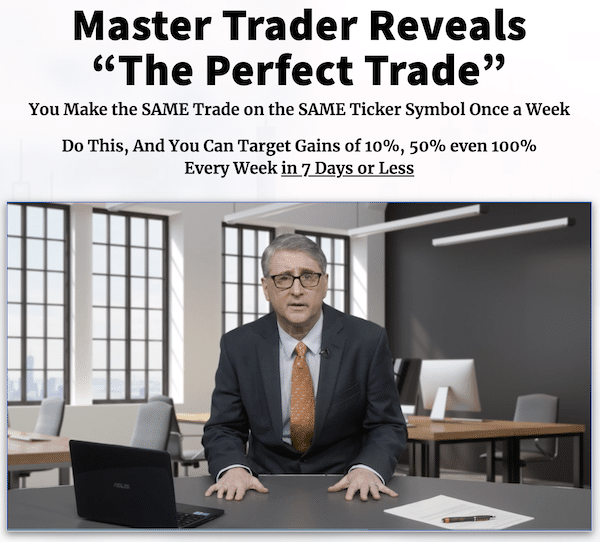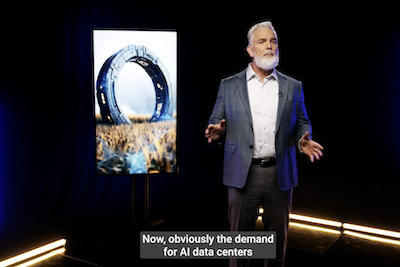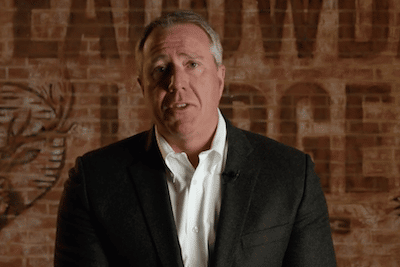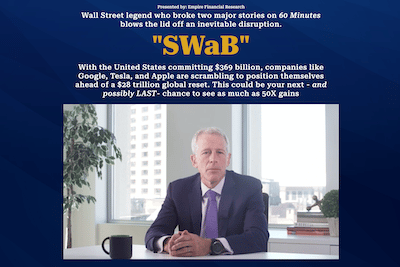Welcome to my review of Michael Carr’s One Trade service.
I recently stumbled across a presentation about this service on the Banyan Hill website, where Michael Carr talked about making gains of 100% or more each week with a single trade.

I was skeptical but wanted to know more about it to see if it’s as good as he claims or if it’s really just another overhyped scam. So I decided to look further into it.
In this review, I’ll show you what I learned about One Trade, walk you through how the system works, and shed some light on who Michael Carr is to help you decide if it’s right for you.
Overview of Michael Carr’s One Trade
According to Michael Carr, the man behind One Trade, his strategy is so simple you can place one trade once per week, using the same ticker symbol and target gains of 100% plus each time.
A strategy so simple, you can make the same trade on the same ticker symbol once a week and target potential gains of 100% or more each time.
Michael Carr (Source: pro.banyanhill.com/p/CAR2020_EXT/WCARW609/Full)
He says he uses a “proprietary algorithm” that monitors the market’s recent price action and tells him which direction the market is likely headed, either up or down.
From there, with the help of 40 rules he has programmed into his software, Mike says he identifies the best trade opportunity for the coming week and shares it with subscribers.
As a subscriber, Mike says all you need to do is check your email at 9:15 in the morning and follow his instructions to place his recommended trade.
And apparently, it’s been paying off pretty well so far.
According to Mike, some of his trade recommendations have made his beta testers up to 556% in less than a week. However, he does make it clear that this is an outlier.
He normally recommends one or two trades per week, and the average trade lasts around two days. And during the final six months of testing, he says his beta testers made 21.7% gains on average. This accounts for both the winning and losing trades.
Even our average trade over the last six months of our beta test did 21.7% in 48 hours … with one to two trades per week. When you’re able to do that every week, the money racks up fast. And my goal is to give you the exact same opportunity.
So even though 100% gains are possible, Mike says the average gain is 21.7%.
If true, that’s still pretty incredible. That may not sound like a lot, but that is very high in the world of trading. In fact, it’s high enough to make me skeptical.
Let’s do the math on 21.7% gains each week for a year…
Mike guarantees he’ll send you at least 50 trade recommendations over 12 months, and let’s say you start with a $10,000 trading account. That works out to $2,170 profit per trade on average over 50 trades, or $108,500 for the year. And that’s without reinvesting your earnings.
So, that logically means he’s saying you could 10X your money in one year, right?
Nope. As I’ll explain shortly, that’s not what he’s saying if you look closely at his entire presentation. He’s actually saying you could double your money over a 12 month period.
Still, regardless of the overall gains, 21.7% per trade is impressive.
What’s his “secret” to success?
Well, for starters, Mike is a Chartered Market Technician (CMT) and a Certified Financial Technician (CFTe). He also says he used to build rockets for the U.S. government.
So that probably helps (lol).
But he says his One Trade strategy is based on a proprietary set of 40 rules and that he only trades one specific ETF using options, called the SPDR Dow Jones Industrial Average.
In the next section, we’ll discuss how his strategy works in more detail.
How Does Mike’s One Trade Strategy Work?
As a subscriber of One Trade, the way the service works is pretty straightforward. You just need to sign up, check your email each morning at 9:15 am, and decide if you want to follow Mike’s trade recommendations using your own brokerage account.
Everything you need to follow along is included in the membership. You get a starter guide, daily briefings, weekly trade recommendations, instructions on how to place each trade, the whole nine yards. Your main job is to follow along and “hope” that Mike is on top of things.
Which in some ways makes it simple, but in other ways, it’s risky because you’re placing an enormous amount of faith in one person to make you money consistently.
Nevertheless, Mike says he is an expert and that his strategy results from 25,000 hours of market research. Apparently, it considers technical factors like Sharpe ratios, Z-scores, standard deviation, and 40 proprietary rules he has programmed into his computer.
I’m not privy to his proprietary algorithm or the details of each of his 40 rules. But I do have an understanding of the overall mechanics of how his strategy works.
Essentially, all Mike is doing is betting on the direction of one ETF each week, the SPDR Dow Jones Industrial Average (DIA). And he does so using options.
DIA is an ETF (exchange-traded fund) that essentially replicates the performance of the Dow, which is a price-weighted index made up of 30 blue-chip stocks including top-performing U.S. companies like Apple, Microsoft, Boeing, Nike, and Wal-Mart, among others.
Mike uses options because these allow you to speculate on the future price movement of a security, which in this case is DIA, whether it goes up or down. And options can allow you to make more money with less upfront capital.
On the other hand, options trading is more complicated, and you don’t own the underlying security, so if you’re wrong, you can lose your entire stake in one go. This is why Mike only recommends using 10% of your investment capital into any one trade idea he gives you.
In any case, there are basically five parts to Mike’s approach of determining which direction the DIA ETF is likely headed over the coming week and, therefore, what his recommendation will be.
He says the first part of his process involves him “running calculations” each day.
Next, he says he uses a computer program with 40 different “proprietary rules,” in conjunction with a “proprietary algorithm” that scans these rules and the market each day and lets him know if the market has a 75% probability of going up or down in the week ahead.
Third, Mike says he uses a volatility indicator he developed that tells him where to expect the market to be two weeks in advance.
And apparently, when all of this lines up, it’s the “perfect opportunity to profit.”
From here, Mike says the fourth step is where he applies his “years of market expertise” to analyze the trade and make sure it’s something he wants to back.
And if he’s happy with the trade, the fifth step is he recommends it to One Trade subscribers by 9:15 a.m. via email and gives you the details on what to buy, at what price, and when.
Sounds simple enough, I guess.
But the real question is whether or not it actually works and whether or not it will continue to work over the course of a 12-month membership.
For the most part, we have to take Mike’s word that his system has worked for his beta testers as well as he says it has. And nobody can predict the future, so it’s hard to know for sure how well his future recommendations will play out.
But we can take a look at Michael Carr himself and what his track record is like because that can help us get an idea of how likely his predictions will be worthwhile moving forward.
Recommended: Go here to see my #1 rated stock advisory of 2024
Who Is Michael Carr?

Michael Carr, commonly referred to as Mike, says he is (literally) a rocket scientist who has over 20 years of professional trading experience.
Apparently, he used to design weapons for the U.S. military which later helped him in the stock market given how precise he had to be with his calculations.
Designing nuclear weapons, I had to double, triple and quadruple check every input … every decimal … every line of code … every calculation … so that when the moment came to hit “the big red button,” I knew my missiles would go exactly where they were meant to.
I carry that same mindset — the same I used as an officer in the armed forces — every single day the stock market is open.
According to his bio on the Banyan Hill Publishing website, Mike also helped develop an early version of the internet and deploying radar systems to track Soviet aircraft.
A veteran of the U.S. Air Force, Michael started his career at the Pentagon, where he was instrumental in the installation of the facility’s first local area network, an early version of the modern-day internet. He was later moved to a bunker in Iceland where he was involved with deploying state-of-the-art radar systems to track Soviet aircraft near the end of the Cold War.
Source: banyanhill.com/expert/michael-carr
How did he get into investing and trading?
According to his website, after spending almost 20 years developing pattern recognition software for the U.S. Air Force, he retired in 2005 and put these skills to work in the stock market.
This led him to publish a book in 2008 called “Smarter Investing in Any Economy: The Definitive Guide to Relative Strength.” And when he was doing a presenting about the book at a conference, a small investment firm asked him to work for them. Which he says he did and, as a result, helped the firm turn $80 million into $200 million in assets under management in two years.
From there, Mike says he decided to get into financial education and joined Banyan Hill Publishing, where he contributes to a free email newsletter called True Options Masters and runs three of his own paid advisory services: One Trade, Peak Velocity Trader, and Precision Profits.
He’s also a Chartered Market Technician (CMT) and Certified Financial Technician (CFTe).
The last CMT I came across on this blog is Adam O’Dell. And as I explain in my review of his program, Green Zone Fortunes, this is a designation given to competent technical analysts by an organization called the CMT Association.
A Certified Financial Technician (CFTe) is an accreditation given by the International Federation of Technical Analysts (IFTA) upon completing a course that tests a person’s technical skills, knowledge, and understanding of ethics.
On top of all this, Mike contributes to several other trading publications outside of Banyan Hill, teaches at the New York Institute of Finance, and says he has recommended 50 triple-digit trades across all of his research services since he started with Banyan Hill.
So I think it’s safe to say that not only is Michael Carr a real trading expert with over two decades of experience, but he is highly qualified and well-respected in the industry.
What Do You Get If You Join One Trade?
The main thing you get as a member of One Trade is the weekly trade recommendations.
Over the course of a 12-month subscription, you get at least 50 trade recommendations. Some weeks you get one trade idea, others you get two, but you get at least 50 per year on average.
As part of this, you get access to a Daily Briefing sent to you via email at 9:15 am every morning. This details what Mike recommends you do with his current trade recommendations and details any new recommendations.
Another key part of the service is the dedicated weekly newsletter.
This gives you the heads up on what direction Mike believes the market will move in the week ahead and provides you with his insights on the market.
To help you get started and follow along with Mike’s weekly trade recommendations, subscribers also receive a copy of The One Trade Starter’s Guide and The One Trade Rulebook.
And to help you keep track of all of Mike’s active recommendations, you get access to the model portfolio located inside the member’s area.
Lastly, as of writing, Banyan Hill is giving new members access to a premium weekly newsletter called Market Intel which details Mike’s thoughts on the market.
How Much Does It Cost to Join?
The cost of joining One Trade is normally $3,997 per year; however, as of writing, it currently costs $1,495 per year to sign up through the Banyan Hill website.
And it renews automatically at this price each year.
Paying $1,495 to join a trading service is up there. This is definitely one of the more expensive trading advisory services I’ve reviewed. But it’s also fairly comprehensive and run by someone with more credentials than the “gurus” running some other trading services I’ve reviewed.
And either way, I guess the idea is that if Mike’s average trade really does generate 21.7% returns, it theoretically wouldn’t take very long to earn that money back.
Are there any guarantees?
There is no guarantee you will make money with Mike’s One Trade service. Nobody can rightfully promise anyone will make money using their service because nobody can predict the future.
And there is no money money-back guarantee on this service either.
The only guarantee you get is that if the service doesn’t provide you with a profit after one year and five triple-digit trade recommendations, you get a second year for free.
How Much Can You Make With One Trade?
As mentioned earlier, Mike says his service had generated 21.7% gains when his beta testers used it for six months. So, assuming that’s correct, and you receive 50 trade recommendations in 12 months, that might lead you to assume you could 10X your money over the space of a year.
But that’s not exactly the case.
Because Mike only recommends using 10% of your money on any one trade.
Earlier I gave the example of turning $10K into over $100K using Mike’s metrics, but that would not be the case if you only traded with 10% of your money. In that case, when you do the math, your returns would be more like doubling your money over 12 months.
For example:
- Start with $10,000
- Place 50 trades over 12 months with each trade being $1,000
- That works out to making $10,850
And this helps clarify something I noticed during the presentation that was bugging me…
Throughout most of the presentation, Mike talked about how you could generate 21.7% gains from each trade on average. Yet, in one section towards the end, he talks about how you could double your money in 12 months. Which immediately struck me as odd.
Here’s the part of the presentation I’m talking about (emphasis mine):
Meanwhile, in just the first eight months of 2020, following my equal allocation strategy where we put the same amount into every weekly trade, we’re UP 65%.
That is more than triple the Nasdaq and more than 10X the S&P 500.
To reach this number, I funded a $10,000 charity account on January 1.
Every time I recommend a trade, one of my team members places the trade just like a regular subscriber. He buys the same amount each time, and in the first eight months, that $10,000 account has yielded over $6,500 in profit.
If I can keep that pace up through year-end, we’ll hit 100% … and I will have doubled my money in one year.
I want to give you that exact same chance.
I was puzzled by this at first because, on the one hand, he’s talking about making an average of 21.7% gain from every trade, and on the other, he’s talking about doubling your money in a year.
It made no sense.
Then I realized that this actually does make sense if you’re only using 10% of your capital on each weekly trade Mike recommends.
So to come back to the question of how much you can make…
There are no guarantees you’ll make any money at all.
However, based on what Michael says, you could make an average of 21.7% from each trade. Which, if you follow his strategy properly, by only betting 10% of your capital on any one of his recommendations, that would theoretically lead to doubling your money in a year.
To be fair, at no point does Mike say you can 10X your money.
That’s just the assumption you could easily make if you were caught up in the excitement and didn’t take the time to analyze what he said thoroughly. Which, let’s face it, few people do.
Is Michael Carr’s One Trade Service Legit?
I don’t believe Michael Carr’s One Trade is a scam.
It’s a real service run by Michael Carr, a respected trading expert with over two decades of experience, and it’s backed by Banyan Hill, a well-known financial publisher.
That said, I think it’s important to understand that there are no guarantees you’ll actually make money with the service other than getting a second year of service for free.
So it is possible you could lose money following the One Trade recommendations.
I also think it’s worth taking some of the marketing with a pinch of salt. At a glance, it would be relatively easy to assume that, based on the 21.7% average gain per trade, you can 10X your money over 12 months. But as I showed earlier, that’s not necessarily the case.
Either way, it is a legitimate service, and I do like that Mike is not recommending his subscribers go all-in on every trade he recommends. That, to me, makes a lot of sense.
Bottom Line
One Trade is a trading advisory service headed up by Michael Carr of Banyan Hill Publishing that provides subscribers with weekly options trade recommendations.
Each trade recommendation is based on the SPDR Dow Jones Industrial Average ETF (DIA) movement, up or down. And for $1,495, you get at least 50 recommendations along with other resources aimed at helping you become a successful trader.
Overall, I think it could be worthwhile if you’re interested in making money with a relatively straightforward options trading strategy.
At the same time, you are relying heavily on one person’s trade ideas, and there are no guarantees his recommendations will generate you a profit. So even though it could be worth checking out, I wouldn’t rush into it expecting to get rich quickly.












Please note: By submitting a comment using the above comment form, you confirm that you agree with the storage and handling of your data by this site as detailed in our Privacy Policy.